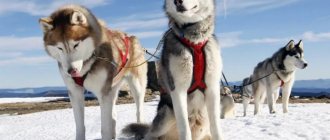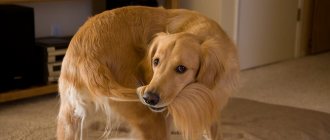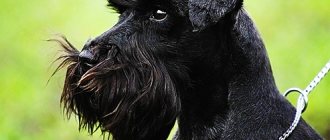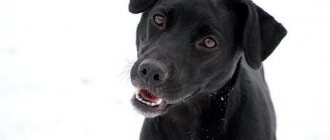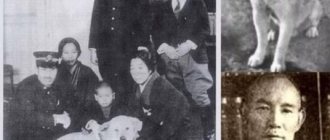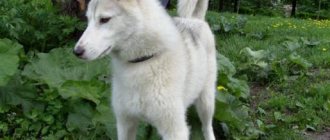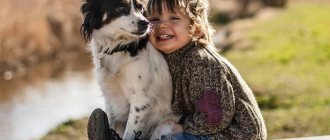A guide dog is an assistant and a faithful friend
Guide dogs are specially trained to help blind people move around on the street. They are not only irreplaceable companions that help you avoid obstacles on the road, but also life guides that open up new opportunities and awaken interest in the world around you.
The history of guide dogs goes back hundreds of years. Animal training schools began to appear in the 20-30s of the last century in the USA, Great Britain, and Germany for blind war veterans. Many people with vision problems do not dare to have four-legged companions due to the lack of necessary information and various myths about them.
Labrador
The Labrador is an ideal guide dog. He is distinguished by patience, energy, and good nature. Many blind people choose this breed as their helper. Labradors are very active, smart, and not indifferent to children. A Labrador guide dog easily remembers new roads and learns commands.
Breeds of guide dogs
According to experienced dog handlers, only the smartest dogs become reliable guide dogs; according to statistics, this is about a quarter of the hundreds of animals of selected breeds.
A guide dog for the blind must naturally have:
- medium size (no more than 65-68 cm at the withers);
- excellent hearing and excellent vision;
- good disposition;
- the ability to extinguish natural instincts.
The breeds that best meet these criteria are collies, Labrador retrievers and German shepherds. They are maximally capable of learning. Females have an advantage in selection, since their calm disposition is more stable at different time periods of life.
Collie. Since ancient times, the breed has been used as a guard dog for herding sheep. A reliable assistant to shepherds, he is endowed with the instinct of a protector and rescuer. Later, the dog was trained to lead people out of the fire and serve as a guard. Collie is an ideal guide for children with visual impairments. The character of the animal has a psychotherapeutic effect in the process of communication.
In the photo there is a collie guide dog
Labrador retrievers. Innate friendliness and intelligence make dogs reliable friends of blind people. They not only serve as guides, but can help with housekeeping: turning off the lights, bringing and putting away the necessary medicines, telephones, necessary items, things.
With them, an atmosphere of comfort is created, life is filled with interests and opens up opportunities to solve problems that were previously insurmountable. Love for the owner and devotion to a person change the worldview of a blind person, giving him vital energy and strength.
The photo shows a guide dog of the Labrador breed
German Shepherds. Dogs of this breed are known for their fearless courage and having a strong nervous system. Working with police services, rescuers from the elements of fire and water confirms the reliability, intelligence, and stress resistance of guide dogs . The breed is well trained and taught escort skills.
Rottweilers and Giant Schnauzers are also often trained as guide dogs. Natural sociability, the ability not only to carry out the owner’s commands, but also to evaluate their correctness in the current situation reflect their intelligence, devotion and caring for the person.
It is possible to train other breeds as long as the puppy is gifted, obedient and friendly towards people. After all, guide dogs have to accompany their owner on public transport, on noisy streets, not react to other animals, and not be distracted from the main task of ensuring safe movement.
The photo shows a German Shepherd guide dog
Important Character Traits
It should be remembered that no amount of training can deprive a dog of its self-esteem and its way of looking at things. The Labrador has its own opinion regarding all aspects of its life and the life of its owner. For example, if he decides to sleep on your bed, no force will drive him away from there. No, of course, you can push him away, but in a few minutes or hours he will return.
Or food. Labradors love to eat. Even after a hearty breakfast, during a walk he will still pick up all sorts of nasty things from the ground. And after a walk, he may well stick his nose into your lunch.
This is due to one important physiological characteristic - Labradors do not feel full and do not understand when to stop eating. After quality training, of course, the dog will be embarrassed (really embarrassed) to pick up food from the ground and poke into the owner’s plate, but this does not solve all the problems - a Labrador requires an eye and an eye.
Dogs of this breed are also distinguished by a particularly strong love of water, which is genetically inherent in them - we remind you that they “came from the sea.” If suddenly during a walk you “lost” your pet, feel free to head to the nearest body of water.
Dogs also love water games. They are excellent swimmers and can even find drowned objects. They also love scuba diving and are able to spend quite a lot of time underwater. Therefore, if suddenly your pet dives and has not appeared on the surface for about five minutes, do not panic and rush to the rescue. If you swim worse than a dog, most likely you will need the money.
If you reach a pond while walking, consider that you have no free time left. Sit on the shore and wait - the dog will have fun, play and swim for two to three hours.
Puppies love water too. Therefore, when keeping them in an apartment, be prepared at any time to fill the bathtub and throw in a few toys - the dog’s favorite ones and those just floating.
Guide dog training
The further result of training the skills of a guide dog depends on the correct choice of the puppy. Babies are selected already in the second month of life based on their level of endurance, patience, friendliness and ability to obey. Kind and affectionate puppies are tested to see if they have a natural talent for service and a willingness to learn.
Guide dog school is not for everyone; only a quarter of the selected puppies of the most suitable breeds and qualities remain for important training. Here, student dogs are never punished so as not to undermine the animal’s trust.
Experts are confident that it is impossible to achieve a pet’s loyalty by inflicting pain and causing fear. In a human-dog pair, the owner must dominate, and the guide gives his loyalty and service.
Guide dog training
Puppies first live in foster families and learn simple commands in their own environment. Real training begins at 8-10 months, if the dog has shown the makings of a guide dog.
Trained dogs often treat their owners in such a way that they replace them with relatives at heart. The ability of an animal to protect a person in an unusual situation is the result of special upbringing. The training of guide dogs ends with a real exam, after which the joint work of the instructor, the dog owner and the guide dog begins.
The dog receives a certificate allowing its presence in all public places. The owner of the dog is given detailed instructions on the nature of communication with the pet so that their relationship becomes reliable and long-lasting. Each breed of dog, an excellent guide dog , is especially successful if there have already been assistants to the blind or therapists for sick children in the family.
In the photo there is a guide puppy
Education
As mentioned above, Labrador Retrievers are very intelligent and easy to train dogs. And therefore, almost any puppy owner strives to begin the training process as soon as possible. However, after the very first loudly spoken unpleasant word, the dog turns from cheerful and playful into a touching puppy with sad and even slightly whiny eyes - like those of a hungry child. It is clear that the heart of most owners begins to break with shame, people blame themselves for the cruel treatment of this baby, and the training process stops before it even begins.
And this is a common mistake. Labradors are very smart and know very well that no person can resist a whiny little face. And the owner can check this statement himself. One has only to take the stored treat out of his pocket and smile, and all the dog’s grief dissolves without a trace.
When training a puppy, there are two basic rules - he needs to be fed (as a reward) and he needs to be played with. While playing, he may simply “forget” that we are talking about learning.
It is also important to remember one thing - no aggression. Friendly by nature, the Labrador wants its owner to be friendly too. A few “mistakes”, screams or, even more so, even blows - and that’s it, you have lost a kind, smart and devoted friend.
What a guide dog can do
A trained guide dog copes with the following main tasks:
- be focused and suppress instincts;
- overcome obstacles on the road (puddles, stones, curbs, steps) and give signs about them to the owner;
- accompany a blind person through the streets and intersections;
- guide a person in movement on climbs, stairs, turns, through narrow passages;
- master familiar routes, on average up to 35-40, from your place of residence and back.
A true guide is not afraid of people and vehicles, and is attentive to the actions and well-being of the owner, provided that he behaves competently. Buying a guide dog is the first step, and the second is the ability to give commands and maintain the skills the dog has learned. After the transfer of the pupils, dog handlers continue to advise the owners for some time.
The main task of the dog is to reduce the dependence of blind people on strangers and to provide psychological support to a person with disabilities.
They do not have protective instincts, since guide dogs do not show aggression towards strangers. Devotion and loyalty to the owner are their integral qualities. The price of a guide dog is never low, but for the blind these helpers are priceless.
Reasonable disobedience
This is an especially important skill that every guide dog should master. A properly trained handler will not carry out commands that could endanger the owner's safety. In such situations, he “takes command” and acts according to his own decisions.
While listening to a person's commands, the dog also reasons independently. For example, a blind person decides to cross the street at the moment when several cars are approaching the crossing. This can lead to injury and even death in an accident. In this situation, the guide dog will not obey the person, thereby ensuring the safety of him and himself.
Attachment to the owner in guide dogs
The presence of a person and a dog together forms mutual affection. There are examples of guide dogs giving their lives to protect their owners from danger.
For faithful service, monuments are erected to guide dogs in gratitude for their invaluable help. The talent of selfless service and natural kindness work wonders. Blind people also have a love for animals. After the death of a four-legged friend, blind people very rarely get another guide. Apparently it’s not just a leash that connects a person’s hand and a dog’s collar, but something much more.
Story
The first mention of four-legged guides dates back to the Middle Ages. Even then, people deprived of sight trusted dogs with their lives and health. But the first professional trainer of guide dogs was Johann Wilhelm Klein, who published a book on their training/use in 1819, and also founded the Institute for the Training of the Blind (Vienna).
This is interesting! Systematic training with dogs began almost 100 years later, after the First World War, when a special school was created in Germany: here animals were taught to help people who were blinded in the war. The school was supported by the German Red Cross, and in 1925 the fame of its achievements flew around the world.
In our country, professional training of guide dogs began after the Great Patriotic War, when thousands of strong men who had lost their sight returned from the front.
The country needed workers and engineering personnel, for the training/retraining of which schools, boarding schools and training and production enterprises were opened. Visually impaired people had to not only learn how to work again, but also move freely, without relying on the help of strangers. Their only companions were guide dogs, the first batch of which were trained by the Central School of Service Dog Breeding and handed over to blind front-line soldiers in 1947.
The Central Republican School for the Training of Guide Dogs appeared in 1960 thanks to the initiative of the All-Russian Society of the Blind. Its instructors were military officers who trained and used dogs in front conditions. The German training method was adjusted over time, taking into account the accumulated experience, the peculiarities of the work of guide dogs in the USSR and the wishes of the blind themselves.
Training dogs for people with disabilities turned out to be in demand, and already in 1999 a new organization arose, the core of which were instructors from the VOS school (at first, they trained dogs on a voluntary basis). In 2003, the organization changed its legal status and is now called “Training and Cynological. Not far from Moscow there is a second center that trains four-legged guide dogs - the Russian School for Training Guide Dogs .
Return to content

